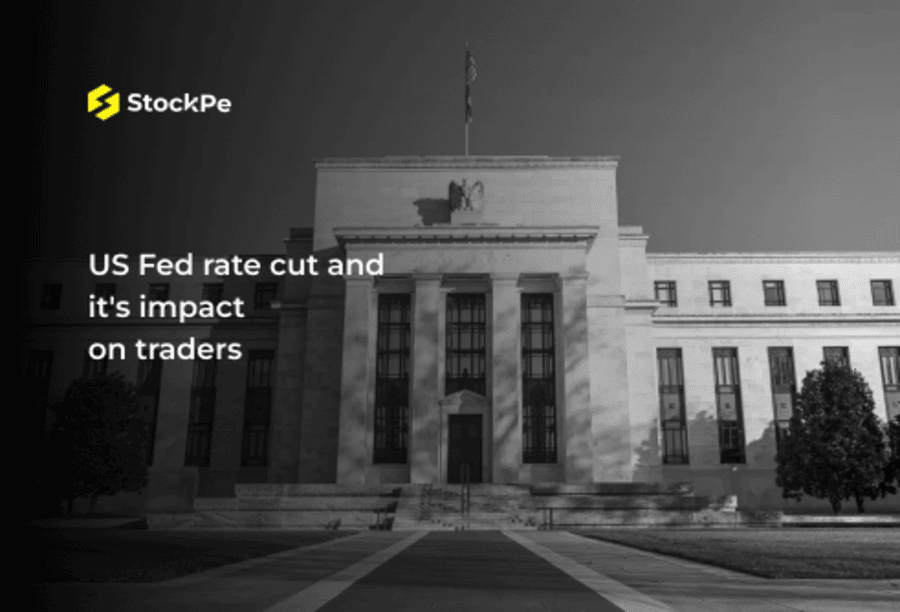The US central bank known as the Federal Reserve, or the Fed, is precisely responsible for setting the short-term interest rates. Such decisions are made at its bi-weekly meetings. These meetings are under a lot of scrutiny, not just in the United States of America but all across the world. This is because the actions undertaken by the Fed are certain to affect different markets and economies.
In this write-up, let us understand what a Fed rate cut is, its significance, and how it affects traders across the US and beyond.
Understanding the Fed Rate and Its Importance!
The Fed Rate or the federal funds rate refers to the rate at which banks in the United States borrow money from each other. This is mainly on an overnight basis. You may compare it to the repo rate for India that is established by the Reserve Bank of India (RBI).
This rate is then used by the Fed to curb inflation, enhance employment, and ensure stability in the economy. When the Fed changes this rate, it affects the interest rates for borrowing. This involves practically everything including home loans, car loans, and credit card interest rates.
For instance, if the Fed chases a rate to be at 2%, there is a capacity for lending from one bank to another at that set rate. A higher rate usually leads to a decrease in spending and borrowing. This is because it becomes costly to borrow. Whereas, a lower rate tends to encourage borrowing and spending.
The Fed’s Recent Rate Cut
However, new to the trend, the Fed recently reduced interest rates by 50 bps during its meeting in September 2024. There was an expectation of a cut in the rate. But most economists expected that it would be of only 25 basis points. The bigger 50 bps cut caught many off guard and indicated that the Fed was beginning to worry about the slowdown of the economy in the US.
Then, the question arises: why did the Fed reduce rates, and what does it lead to?
Reasons for the Fed’s Rate Cut
- Weakening Economic Indicators: The flow of business and employment in the United States is slowing down with the rates of unemployment increasing. For instance, the recent job report published by the US stated that it had created less number of jobs than it anticipated. This hints at the health of the economy.
- Inflation Concerns: While inflation had been declining, the Fed wanted to remain guarded against future inflationary pressures. The US inflation rate predicted by the Fed, using the PCE index is forecasted to stand at 2.3% in 2024.
- Global Economic Uncertainty: Political risks and tariffs dampened economic expectations. These are the other reasons that contributed to the relaxation of the financial conditions by the Fed.
To reduce rates, the Fed hopes to spur demand and spending because increasing borrowing results in the economy’s growth. Also reducing borrowing results in a deeper economic decline. Hence, this decision has its risks, especially if the inflation rates spike.
Impact of the Fed Rate Cut on the Indian Economy
The Fed rate cut mainly focuses on the US economy, but it impacts other economies; this is the case with the Indian economy. Here’s how:
- Lower Cost of Borrowing in India: The RBI may reduce its repo rates as a means of responding to lower interbank rates. When the Fed slashes the rates, the RBI is free to make similar cuts without fear of capital flight (money leaving India). This can reduce the cost of funds domestically and uplift the economic activity.
- Rupee Appreciation: The Fed rate cut typically lowers the value of the dollar. This is as investors fix their eyes on better returns through other markets, like the emerging markets in India. This can lead to an appreciation of the Indian Rupee relative to the US dollar. It may also result in a lower inflation rate in India. A higher value of the rupee translates to better benefits to the import business since imported goods are cheaper. Whereas, the export business is adversely affected since Indian goods become expensive in the global market.
- Impact on Inflation: An appreciated value of the rupee can lower the price of importation of goods. This may include crude oil or electronics, making it easier for India to overturn its inflation rate.
Impact on the Indian Share Market
The Fed rate cut also influences the Indian stock market in several ways:
- Increased Foreign Capital Inflows: When the Fed is just announcing its reduction of the interest rates, the US assets become less appealing to foreign investors. They then peruse other asset markets such as the Indian market. It has been observed that higher amounts of FII inflows can push the stock prices of the Indian market up.
- Sector-Specific Effects: Some industries such as the IT and consumer durables sector may gain more benefits from the rising FII investments. Other sectors that are expected to benefit include the sectors that are export-oriented. It is because the investors are on the lookout for such sectors.
- Market Rally: If foreign capital starts investing in Indian markets, it may help in boosting the stocks. As expected after the latest Fed rate cut, the India FII net Investment in the Indian equity market crossed over Rs 14,000 crore on September 20, 2024.
Impact on the Indian Rupee
- Strengthening of the Rupee: Since the Fed has recently slashed its rates, the US dollar devalues. This equilibrates capital to other currencies like the Indian rupee. This could lead to a more potent rupee or other currencies or the gradual depreciation of the US dollar.
- RBI Intervention: The RBI may come into the market to intervene if the rupee strengthens beyond the required level. It may sell dollars to restrain unreasonable rupee strength. It is because the appreciation of currency can be harmful to the country’s exports.
What Lies Ahead?
Moving forward, the Fed will likely proceed with rate-cutting measures in the coming years. Economists expect the Fed funds rate to average at 3.1% this year. Some are also forecasting that the rates could reach to 4.4% by the end of this year and slightly lower in 2025. This would provide global investors with still more incentive to invest in higher-yielding countries such as India.
Based on the data and charts, it can be noted that the Fed could be moving from inflation targeting to employment. Several factors will be used by the Fed in making its decisions in the future, and the job data will greatly contribute towards this. Predictions being made are that more cuts can foster the global economy as they increase growth and investment.
Final Words
It is crucial to underline that all the actions and decisions made by the Fed are aimed at the US economy. However, they inevitably affect global markets, including the Indian ones. A reduction of Fed rates can bring down interest rates, lead to appreciation of the rupee and foreign fund inflows. But, it has its drawbacks as well, such as inflation. These changes and their impact on the economy and the market must be watched by traders and investors.
Frequently Asked Questions
1. What is this Fed rate and why is it such a big deal?
The Fed rate refers to the rate of interest selected by the Federal Reserve of the US to ease the process of lending between the various financial institutions. It has a role in determining the interest rates for the consumer and business. This, in a way, involves the mortgage as well as loans. An action taken by the Fed regarding the rate can trigger significant effects on the global financial systems.
2. What does a Fed rate cut mean for the stock market?
A Fed rate cut can make equities more attractive to foreign investors thus making the stock prices go up. Some industries such as IT, consumer durables, and export-oriented industries can derive a lot of benefits from foreign capital.
3. What are some reasons why the Fed would decide to cut interest rates?
The Fed lowers interest rates to boost the economy when signs of a slowdown are exhibited. For example, high unemployment level or declining GDP. Higher interest rates make borrowing more expensive, thereby reducing expenditure and investment. This may also cause a recession.





